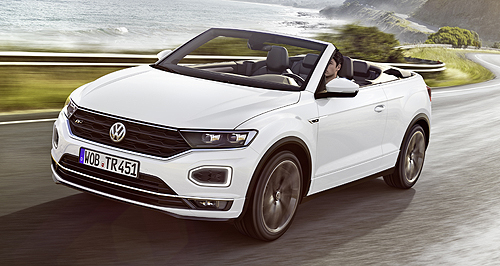New models - Volkswagen - T-Roc - CabrioletFrankfurt show: VW reinvents the cabrioDrop-top T-Roc Cabriolet to return fresh-air motoring to the Volkswagen range14 Aug 2019 VOLKSWAGEN is getting back into the convertible business with the unveiling of a folding-roof version of its T-Roc small crossover.
Due to be unveiled in full at the Frankfurt motor show next month, the T-Roc Cabriolet will create a niche as the first mainstream drop-top small SUV when it hits the roads of Europe just in time for the northern summer next year.
Volkswagen Group Australia says it has no current plans to introduce the two-door, front-wheel-drive cabriolet alongside the hard-roofed T-Roc that will debut in local showrooms in April next year, but VGA general manager of corporate communications Paul Pottinger left the door ajar by adding: “It is an attractive vehicle that we’d consider if it became available.”
VGA has not had a convertible in its range since it dropped the Golf Cabriolet at the end of the Mark 6 Golf’s production run in 2016. A Beetle convertible was also produced overseas during the same era after being launched at the Los Angeles motor show in 2012.
The T-Roc Cabrio sits on the same MQB compact platform as the current Golf, latest T-Roc and a myriad of other models in the VW Group, but it has been drastically re-engineered for open-air driving.
Even though it loses the rear doors, the cabrio is longer than the standard T-Roc in both the wheelbase (2630mm, +34mm) and overall length (4268mm, +34mm).
The folding soft-top makes the roof line 51mm lower, at 1522mm, while the overall width is 8mm narrower at 1811mm.
Rollover protection devices spring up from behind the rear-seat headrests in a fraction of a second if the vehicle tilts beyond a particular point.
A reinforced windscreen frame also adds rollover safety, along with reinforcement in the underbody and various panels, including the doors.
A major selling point of the cabrio is the elevated seating positions that VW says will offer great views during top-down cruising.
The front seats sit 599mm above the road, while stadium-style rear seats are higher, at 616mm.
Two turbo petrol powertrains will be available at launch in Europe – a 1.5-litre three-cylinder producing 85kW of power and 200Nm of torque, and a 2.0-litre four-cylinder that develops 110kW and 250Nm.
The smaller engine comes with a six-speed manual gearbox while the larger unit gets a seven-speed dual-clutch automatic transmission.
Both of these engines are less powerful than the 140kW four-cylinder unit that will grace the T-Roc 140TSI hardtop in Australia at launch.
The hardtop will also come with 4Motion all-wheel drive – a system apparently missing from the cabrio, at least at launch.
Other powertrains might become available for Australian customers after trhe T-Roc wagon’s midlife upgrade in about 18 months. These might include the potent 221kW/400Nm turbo petrol engine of the recently released T-Roc R.
The cabrio gets its own SIM card so remains permanently connected via an 8.0-inch touchscreen. A 11.5-inch active display can also be optioned for a full digital cockpit.
Wheels are 17-inch alloys, but 19-inchers can be had with the optional R-Line package.
An alternative Style package can also be ordered, offering a choice of four interior decors with ambient lighting and other touches.  Read more |
|

















Facebook Twitter Instagram